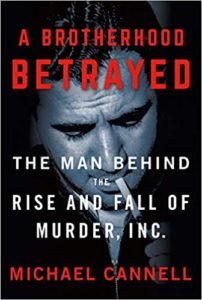The mobster Dutch Schultz died eighty-five years ago this month after a pair of Murder, Inc gunmen shot him in the bathroom of a Newark, New Jersey chop house that served as his temporary meeting place and headquarters.
Schultz’s death earned the lurid front-page banner headlines you might expect from one of organized crime’s ruling figures. His passing also led to one of the oddest experiments in film history. Depression-era Hollywood fell in love with gangster films, but none was anything like the script inspired by Schultz’s death.
In the summer of 1935 New York City was drowning in corruption and violence as Lucky Luciano, Meyer Lansky and other crime bosses solidified their hold on racketeering. To quell the crisis, Governor Herbert Lehman appointed a 33-year-old lawyer named Thomas Dewey as special prosecutor to investigate the mob. At the time, Dewey was known as a a figure of national promise, a former district attorney with a history of convicting his targets with machine-like efficiency. In a radio address broadcast days after his appointment Dewey promised that he would “destroy organized crime and racketeering of all kinds.”
Schultz had reason to believe that he would be Dewey’s first target. Two years earlier, during his tenure as a federal prosecutor, Dewey had charged Schultz with failing to pay taxes on $2 million income from running beer throughout New York City, and from an illegal lottery known as the policy racket that he operated in Harlem.
Schultz was an easy man to hate. The entirety of the New York underworld knew him to be miserly and prone to episodic rages of psychotic violence. He nonetheless won over the upstate town of Malone, New York, site of his tax evasion trial, by buying rounds of drinks in taverns, donating new uniforms to the local baseball team and other acts of local generosity. The townsfolk came to regard Schultz as Robin Hood in a double breasted suit. A jury comprised of farmers shocked the legal establishment by acquitting Schultz, but his release made perfect sense to the recipients of his generosity. “If New York thinks he’s so dangerous,” a local man asked a New York Times reporter, “why don’t they get rid of him down there?”
Schultz knew that he would not be a free man for long: Dewey intended to indict him again, this time on more serious charges. Schultz called an emergency meeting of crime bosses to propose that they kill Dewey before he sent them all to the electric chair. The room did not agree. Lucky Luciano, in particular, argued that Dewey’s death would exert heat on all of them. If Schultz went rogue and killed Dewey then he might break under the pressure of prosecution and testify against fellow gangsters in exchange for lenience. In Luciano’s cold calculation, it was Schultz who must die, not Dewey.
At 10:15 on the night of October 23, 1935 two Murder, Inc, gunmen entered the Palace Chop House with a sawed-off 12-gauge shotgun and a .38 calibre pistol. They found Shultz’s lieutenants in a back dining room tallying the weekly profits from policy rackets and gambling operations. Schultz himself was in the men’s room. He ducked the first shot. The second hit him just below his chest. The bullet passed through Schultz’s body and out the other side, along its way penetrating stomach, large intestine, gall bladder and liver.
By morning Schultz lay in a hospital bed with a 106-degree fever. His wounds festered with infection. A Newark detective rushed to question Schultz before he died, a stenographer at his side. In his morphine delirium Schultz babbled nonsense threats to his enemies and incoherent entreaties to his friends. A stenographer recorded the entire two-hour interrogation, which lasted almost up until his death that evening.
Q: Who shot you?
A: The boss himself….Yes, I don’t know….I am sore and I am going up and I am going to give you honey if I can. Mother is the best bet and don’t let Satan draw you too fast.
Q: What did he shoot you for?
A: Him? John? Over a million, five million dollars….Come on, open the soap buckets. The chimney sweeps. Talk to the sword. Shut up, you big mouth. Please help me up..French-Canadian bean soup. I want to pay. Let them leave me alone.
The stenographer recorded the entire monologue—about two thousand words in all—before Schultz expired. The police hoped that Schultz’s answers, however incoherent, might reveal who shot him, or offer other insights. They did not. It would be five years before detectives arrested Schultz’s killers.
The stream-of-consciousness ramblings were of no use to police, but they did earn a footnote in literary history. William Burroughs, a mentor of sorts to Jack Kerouac and other beat writers, saw a form of accidental poetry in Schultz’s blathering. In 1969, the same year Mario Puzo published “The Godfather,” Burroughs published “The Last Words of Dutch Schultz,” a 115-page book written in the form of a film script, complete with directions for camera angles and sound effects. The book begins with the shooting at the Palace Chop House and flashes back to scenes drawn from Schultz’s Bronx childhood and rise to power as a beer bootlegger, gambling magnate and tax evader hiding from the Internal Revenue Service. The transcript of Schultz’s last words plays alongside thirty-eight ghostly black-and-white photographs of Packard sedans, crap games, mug shots, truck caravans transporting bootleg beer, Tommy guns firing in drive-by shootings. It is a hallucinatory version of a standard gangland biopic. Kirkus Reviews called it “a kind of demented aria, full of unconscious gutter poetry.”
Burroughs never managed to produce the screenplay, nor did he intend to. Though others did. For years the actor Dennis Hopper owned the rights, but nothing came of it.“The Last Words of Dutch Schultz” did make it to the stage. In 1988 a Chicago theater known for the unconventional mounted a production. Burroughs himself attended the opening, and earned a curtain call. The Chicago Tribune called it “entertaining, frequently gritty and full of ugly, funny, occasionally shocking surprises.”
In 2002 Dutch filmmaker Gerrit van Dijk produced a 22-minute version of the script combining live action and pencil-drawn animation. The actor Rutger Hauer speaks Schultz’s part in a slow gravelly baritone. The film unspools like a dying person’s life flashing before their eyes, just as Burroughs intended.
*





















